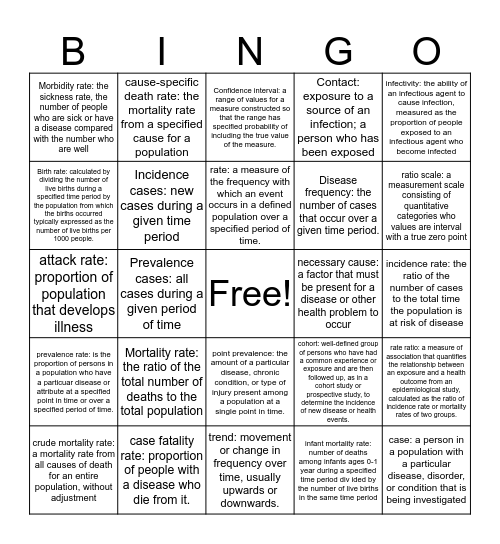

This bingo card has a free space and 24 words: Mortality rate: the ratio of the total number of deaths to the total population, case fatality rate: proportion of people with a disease who die from it., rate: a measure of the frequency with which an event occurs in a defined population over a specified period of time., crude mortality rate: a mortality rate from all causes of death for an entire population, without adjustment, infectivity: the ability of an infectious agent to cause infection, measured as the proportion of people exposed to an infectious agent who become infected, Morbidity rate: the sickness rate, the number of people who are sick or have a disease compared with the number who are well, Birth rate: calculated by dividing the number of live births during a specified time period by the population from which the births occurred typically expressed as the number of live births per 1000 people., cause-specific death rate: the mortality rate from a specified cause for a population, necessary cause: a factor that must be present for a disease or other health problem to occur, point prevalence: the amount of a particular disease, chronic condition, or type of injury present among a population at a single point in time., Disease frequency: the number of cases that occur over a given time period., attack rate: proportion of population that develops illness, cohort: well-defined group of persons who have had a common experience or exposure and are then followed up, as in a cohort study or prospective study, to determine the incidence of new disease or health events., rate ratio: a measure of association that quantifies the relationship between an exposure and a health outcome from an epidemiological study, calculated as the ratio of incidence rate or mortality rates of two groups., Incidence cases: new cases during a given time period, infant mortality rate: number of deaths among infants ages 0-1 year during a specified time period div ided by the number of live births in the same time period, incidence rate: the ratio of the number of cases to the total time the population is at risk of disease, Confidence interval: a range of values for a measure constructed so that the range has specified probability of including the true value of the measure., ratio scale: a measurement scale consisting of quantitative categories who values are interval with a true zero point, Prevalence cases: all cases during a given period of time, case: a person in a population with a particular disease, disorder, or condition that is being investigated, prevalence rate: is the proportion of persons in a population who have a particuar disease or attribute at a specified point in time or over a specified period of time., Contact: exposure to a source of an infection; a person who has been exposed and trend: movement or change in frequency over time, usually upwards or downwards..
Epidemiology in Practice BINGO | Epidemiology Bingo | NS 3600 Bingo: Intro Epi Terms | Epi Bingo | Epidemiology Bingo
Share this URL with your players:
For more control of your online game, create a clone of this card first.
Learn how to conduct a bingo game.
With players vying for a you'll have to call about __ items before someone wins. There's a __% chance that a lucky player would win after calling __ items.
Tip: If you want your game to last longer (on average), add more unique words/images to it.